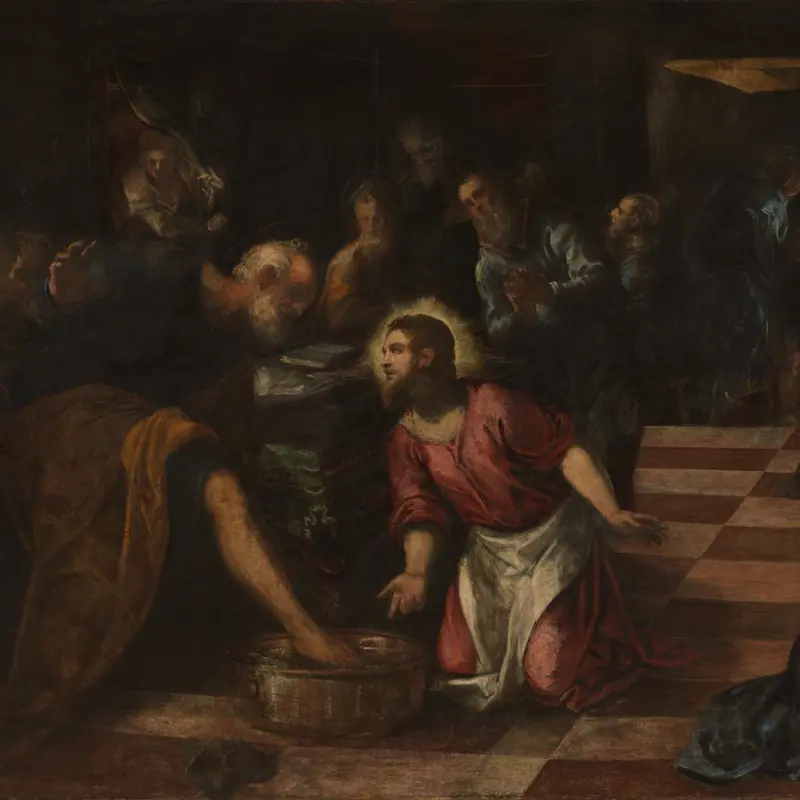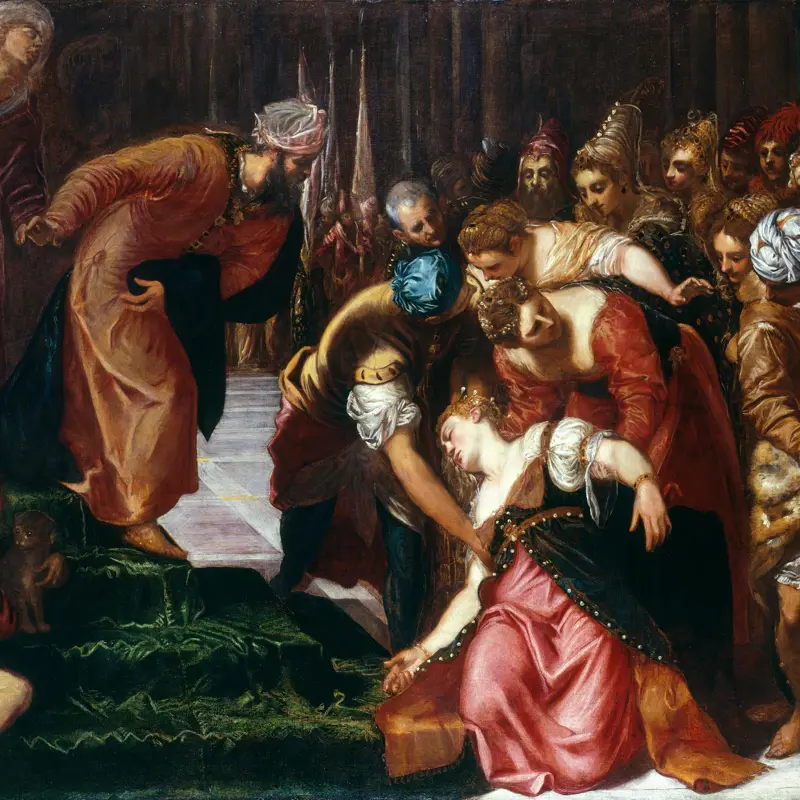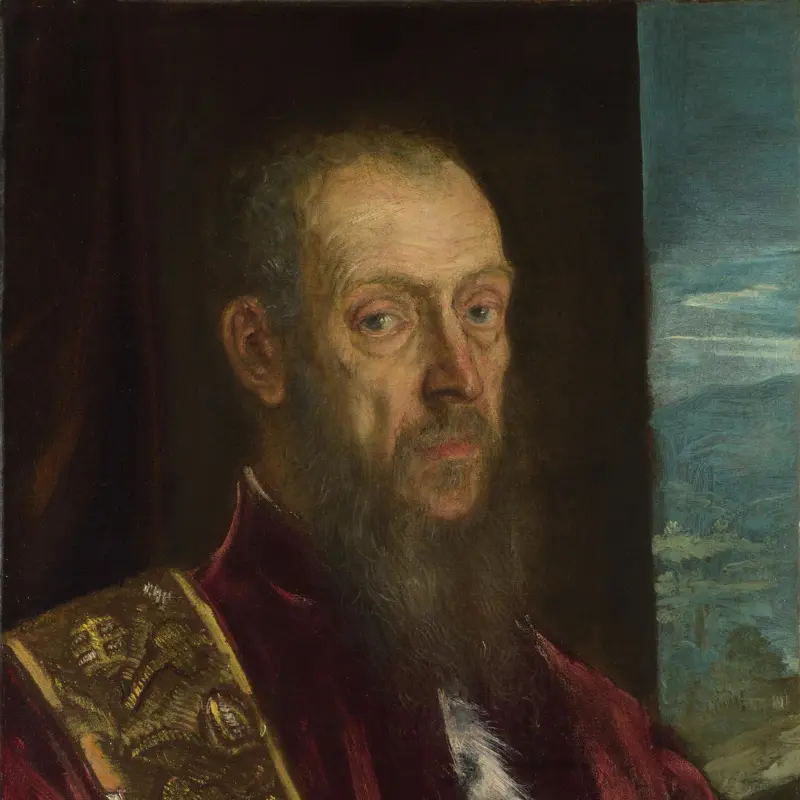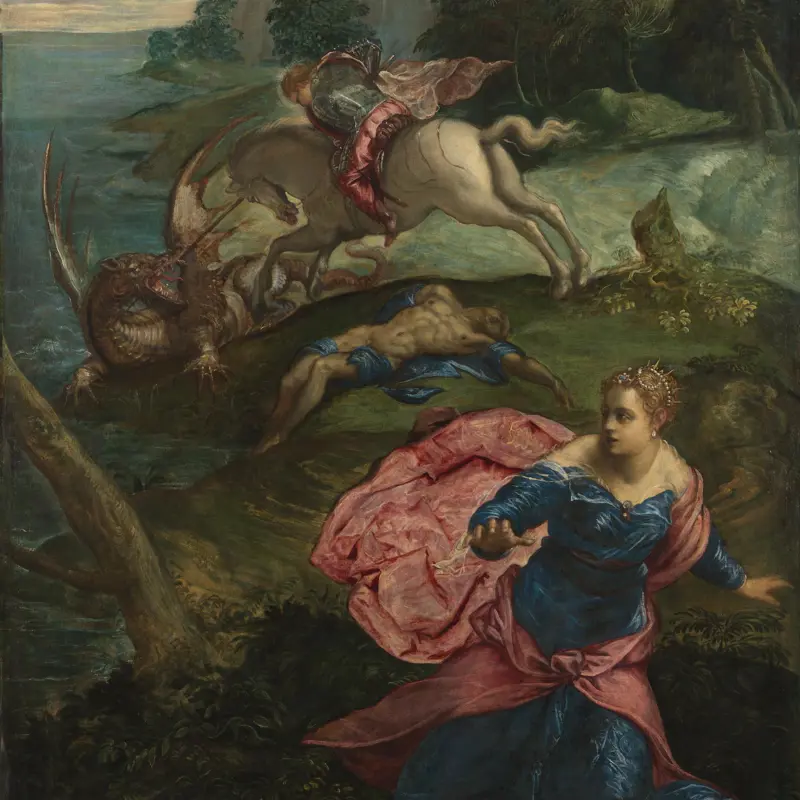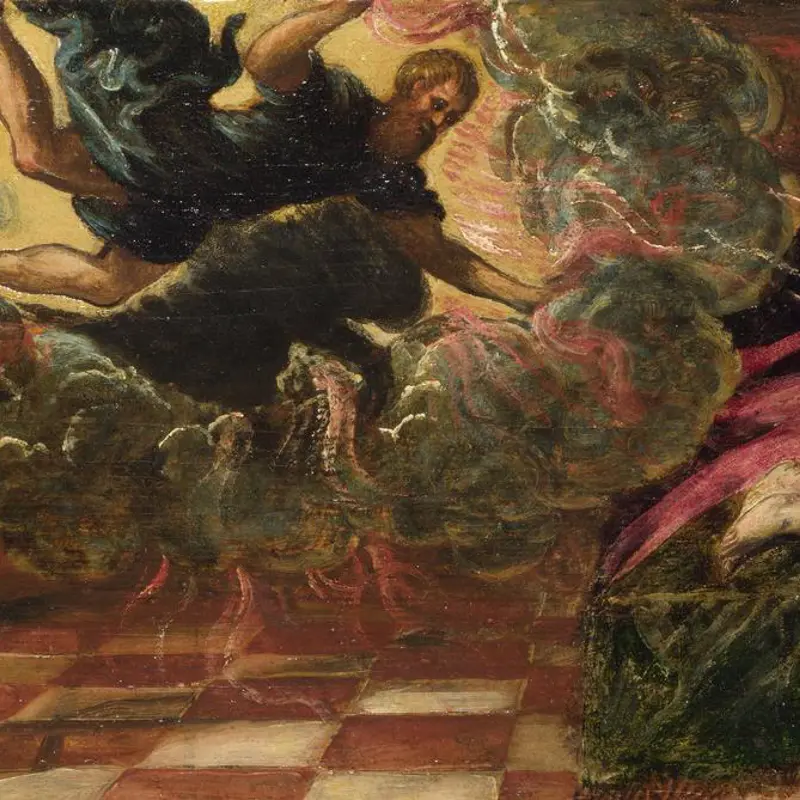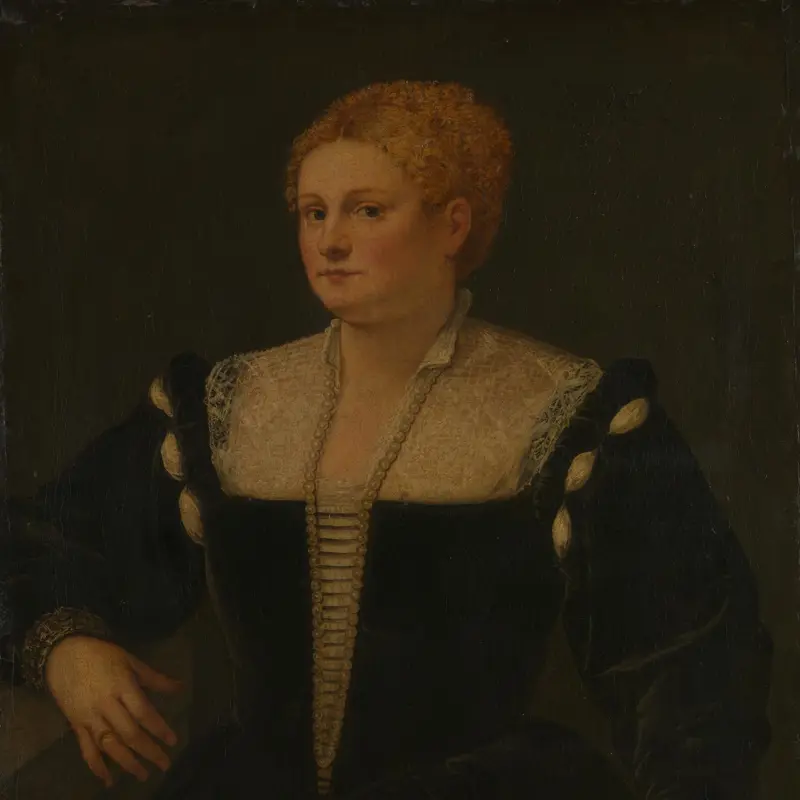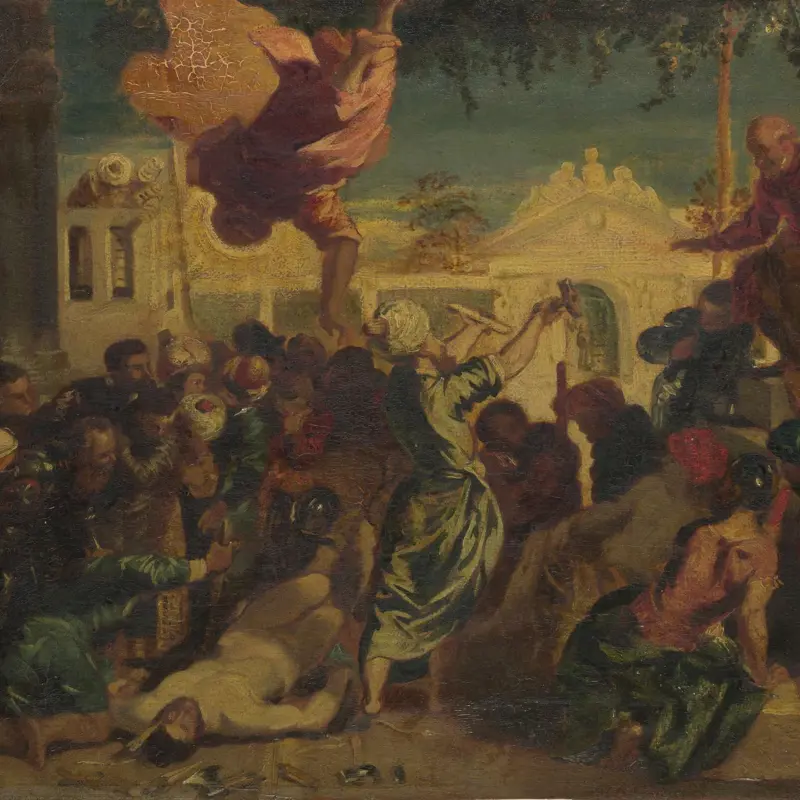Jacopo Tintoretto, 'The Origin of the Milky Way', about 1575
About the work
Overview
The god Jupiter wished to immortalise his infant son Hercules, whose mother was the mortal Alcmene, so he held him to the breast of his sleeping wife, the goddess Juno, to drink her milk. However, Juno woke. The milk which spurted upwards formed the Milky Way, while that which fell downwards gave rise to lilies.
Tintoretto’s painting has been cut down by about a third and what we see now is only the upper part of the original. In the missing lower part, known from a seventeenth-century copy, Ops, the embodiment of Earth and mother of Juno and Jupiter, reclines on a bank beside white flowers. The scene relates to a medal commemorating Tintoretto’s patron, the physician Tommaso Rangone. It is likely that the painting is also connected to Rangone; stars and flowers were both central to his learning.
Key facts
Details
- Full title
- The Origin of the Milky Way
- Artist
- Jacopo Tintoretto
- Artist dates
- about 1518 - 1594
- Date made
- about 1575
- Medium and support
- oil on canvas
- Dimensions
- 149.4 × 168 cm
- Acquisition credit
- Bought, 1890
- Inventory number
- NG1313
- Location
- Room 9
- Collection
- Main Collection
- Frame
- 16th-century Venetian Frame
Provenance
Additional information
Text extracted from the ‘Provenance’ section of the catalogue entry in Nicholas Penny, ‘National Gallery Catalogues: The Sixteenth Century Italian Paintings’, vol. 2, ‘Venice 1540–1600’, London 2008; for further information, see the full catalogue entry.
Exhibition history
-
2018Tintoretto 1519-1594Palazzo Ducale (Venice)7 September 2018 - 6 January 2019National Gallery of Art (Washington DC)10 March 2019 - 7 July 2019
-
2020Masterpieces from the National Gallery, LondonThe National Museum of Western Art18 June 2020 - 18 October 2020The National Museum of Art3 November 2020 - 31 January 2021
-
2021Botticelli to Van Gogh: Masterpieces from the National Gallery, LondonNational Gallery of Australia5 March 2021 - 14 June 2021
Bibliography
-
1648C. Ridolfi, Le maraviglie dell'arte: Overo le vite de gl'illustri pittori veneti, e dello stato, Venice 1648
-
1727L.D. de Saint-Gelais, Description des tableaux du Palais Royal: Avec la vie des peintres à la tête de leurs ouvrages: Dédiée à Monseigneur le duc d'Orleans, premier prince du sang, Paris 1727
-
1798Michael Bryan's Gallery, A Catalogue of the Orléans' Italian Pictures which will be Exhibited for Sale by Private Contract on Wednesday 26th December 1798 and Following Days at the Lyceum in the Strand and at Mr. Bryan's Gallery, 88 Pall Mall, London, 26 December 1798
-
1824W. Buchanan, Memoirs of Painting: With a Chronological History of the Importation of Pictures by the Great Masters into England Since the French Revolution, London 1824
-
1836J.D. Passavant, Tour of a German Artist in England, London 1836
-
1854G.F. Waagen, Treasures of Art in Great Britain: Being and Account of the Chief Collections of Paintings, Drawings, Sculptures, Illuminated Mss. […], vol. 2, trans. E. Eastlake, London 1854
-
1902J.O. Granberg, Kejsar Rudolf II's konstkammare och dess svenska öden, och om uppkomsten af Drottning Kristinas tafvelgalleri i Rom och dess skingrande, Stockholm 1902
-
1903C. Loeser, 'Note intorno ai disegni conservati nella R. Galleria di Venezia', Rassegna d'arte, III/12, 1903, pp. 177-84
-
1910S. Colvin, 'Tintoretto at the British Museum II', The Burlington Magazine, XVI/83, 1910, pp. 254-61
-
1913C. Stryienski, La galerie du régent, Philippe, duc d'Orléans, Paris 1913
-
1934R.N.D. Wilson, The National and Tate Galleries, London 1934
-
1938E. Mandowsky, 'The Origin of the Milky Way in the National Gallery', The Burlington Magazine, LXXII/419, 1938, pp. 88-93
-
1949C. Ridolfi, Tintoretto, ed. D. von Hadeln, trans. R.M. Welsford, London 1949
-
1952E. Newton, Tintoretto, London 1952
-
1957B. Berenson, Italian Pictures of the Renaissance: A List of the Principal Artists and Their Works, with an Index of Places: Venetian School, 2 vols, London 1957
-
1959Gould, Cecil, National Gallery Catalogues: The Sixteenth Century Venetian School, London 1959
-
1959C. Gould, The Sixteenth Century Italian Schools, London 1959
-
1979C. Gould, 'An X-Ray of Tintoretto's "Milky Way"', Arte veneta, XXXII, 1979, pp. 214-9
-
1979J. Plesters, 'Tintoretto's Paintings in the National Gallery: Part I', National Gallery Technical Bulletin, III, 1979, pp. 3-24
-
1980J. Plesters, 'Tintoretto's Paintings in the National Gallery: Part II', National Gallery Technical Bulletin, IV, 1980, pp. 32-47
-
1982R. Pallucchini and P. Rossi, Tintoretto: Le opere sacre e rofane, Milan 1982
-
1985F. Valcanover and T. Pignatti, Tintoretto, New York 1985
-
1987Gould, Cecil, National Gallery Catalogues: The Sixteenth Century Italian Schools, London 1987
-
1995P. Humfrey, Painting in Renaissance Venice, New Haven 1995
-
1996G. Anthofer, Tintoretto as a Mythological Painter, London 1996
-
1996P. Rossi and L. Puppi (eds), Jacopo Tintoretto nel quarto centenario della morte: Atti del convegno internationale di studi (Venezia, 24-26 novembre 1994), Padua 1996
-
1999T. Nichols, Tintoretto: Tradition and Identity, London 1999
-
1999B. Aikema and B.L. Brown (eds), Renaissance Venice and the North: Crosscurrents in the Time of Bellini, Dürer and Titian, (exh. cat. Palazzo Grassi, 5 September 1999 - 9 January 2000), Milano 1999
-
2000R. Morphet et al., Encounters: New Art from Old (exh. cat. The National Gallery, 14 June - 17 September 2000), London 2000
-
2001
C. Baker and T. Henry, The National Gallery: Complete Illustrated Catalogue, London 2001
-
2001L. Konečný, 'The Origin of the Milky Way: Jacopo Tintoretto and Rudolf II', Studia Rudolfina, I, 2001, pp. 17-26
-
2001C.A. Nadeau, 'Blood Mother/milk Mother: Breastfeeding, the Family and the State in Antonio de Guevara's Relox de Príncipes', Hispanic Review, LXIX/2, 2001, pp. 153-74
-
2003L. Impelluso, Gods and Heroes in Art, ed. S. Zuffi, trans. T.M. Hartmann, Los Angeles 2003
-
2006L. Fuccia, 'Note sulla fortuna della pittura veneziana negli inventari di artisti francesi nel seicento, il caso di Claude Vignon ed Esther Forest', Bulletin de l'Association des Historiens de l'Art Italien, XII, 2006, pp. 94-107
-
2007M. Falomir Faus (ed.), Tintoretto (exh. cat. Museo Nacional del Prado, 30 January - 13 May 2007), Madrid 2007
-
2008Penny, Nicholas, National Gallery Catalogues: The Sixteenth Century Italian Paintings, 2, Venice, 1540-1600, London 2008
About this record
If you know more about this work or have spotted an error, please contact us. Please note that exhibition histories are listed from 2009 onwards. Bibliographies may not be complete; more comprehensive information is available in the National Gallery Library.

